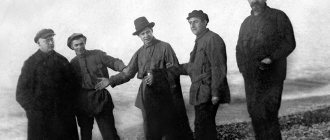History of creation
The poem “Birch” belongs to the poet’s early work. It talks about a beautiful tree in the winter season. From this text it becomes clear how the author treats his native nature with love and reverence. It shows that despite the cold and frost, nature is beautiful. And winter only adds special magic to the surrounding landscape, turning it into a fairy tale.
This poem appeared in 1913 as a young eighteen-year-old boy. It was published in print a year later, under a pseudonym.
The poem “Birch” is dedicated to the poet’s native village of Konstantinovo. Although at that moment he had already moved to Moscow, which captivated him with its capabilities and greatness, he still very often remembered his home. The poem “Birch” is not the only one in the author’s work in which he attaches such memories to his heart.
Plan for stylistic analysis of the poem “White Birch” by S. Yesenin
Plan for stylistic analysis of the poem “White Birch” by S. Yesenin
The author - Sergei Yesenin - is the singing heart of Russia, the poet of the Russian soul. His poems are melodic, majestic, they have the breadth and spaciousness characteristic of Russian song. Romances and songs are based on his poems.
The poem “Birch” was written by Sergei Alexandrovich in 1913, i.e. before the start of the tragic events that changed the history of the Russian Empire (the First World War, the 1917 revolution, the civil war, etc.). 18-year-old Yesenin, who has just radically changed his lifestyle from rural to urban, remains faithful to the former ideals of peasant life, singing in poetry the beauty of his small Motherland.
The style is artistic.
The goal is to influence the feelings and thoughts of readers through the creation of images.
The main function is aesthetic.
The addressee of the speech is a wide segment of society - the intelligentsia, workers, students, etc.
The theme of the text is that S. Yesenin is able to see beauty and splendor in the simplest and most ordinary things, like a magician reviving pictures familiar from childhood with the power of words. The poem “Birch” dates back to the early period of S.A. Yesenin’s work, where Russian nature and rural life determined the themes of his poems. The beauty of this natural world merges with the poet’s ardent love for the Motherland, for Russia. Nature, countryside and homeland are united in his poems in a single sense of beauty. Love for the Motherland was for Yesenin one of the most powerful sources of all his poetry.
Type of speech - description
Type of speech - monologue
Form of speech – written
Sphere of communication – artistic
The genre of the poem is landscape, touching, heartfelt and tender. Features of the composition: the poem has only four stanzas, the first is the semantic center of the work.
The title of the poem is simple and uncomplicated, but very symbolic, because... birch - for the poet, as for most Russian people, is a symbol of Russia, as well as a deep poetic female image, which is repeatedly found in the poet’s work (“... The sleepy birch trees smiled, their silk braids disheveled...”, “... like a stranger’s wife, he hugged the birch tree .").
To convey the emotional mood, the author uses figurative and expressive means and figures of speech.
The structure of the poem is obviously circular, because the first and last stanzas correlate with each other (“... covered with snow, like silver”, “... sprinkles the branches with new silver.”). The absence of a plot, plot development, climax and denouement in the poem speaks of the circular structure of the work.
Yesenin’s bright, original language is replete with comparisons, personifications and metaphors, which creates a bright and original poetic style of Sergei Alexandrovich, unlike anyone else.
Personifications: “... the birch tree... is covered with snow...”, “... snowflakes are burning...”, “... the dawn,... going around, sprinkles the branches...”, etc. Epithets: “white birch”, “sleepy silence”, “golden fire”.
Comparisons: “...covered with snow, like silver.”, “...tassels blossomed with white fringe.”
The beauty of the landscape, its fabulousness and folkloric character is created by such a technique as inversion: “... and the birch tree stands,” “... and the snowflakes are burning.”
Two expressions: “silver” and “in golden fire” attract special attention because they create a mood of solemnity and beauty of the winter birch.
We see the grace and inaccessibility of this cold beauty, but the words “under my window” make the birch more dear, closer. It resembles an elegant image of a bride in a white wedding dress and veil (“tassels with white fringe”). “Snowflakes burn in golden fire” - this is the shining crown of the bride.
In the last stanza the main role is given to dawn. The special role of dawn is emphasized by the conjunction a, which distinguishes it and includes it in the general movement of life. It combines sedateness and majesty. She takes care of the birch tree, like a mother blessing her daughter. It is necessary to pay attention to the phonetic features of the poem: the abundance of drawn-out vowel sounds, especially (e) and (o) (white, birch, snow, silver, sleepy, in golden fire, going around, etc.) and sonorant consonants (p) , (n).
1. White is the key word (white angel, white church, white Rus', white clothes). In the old days, the color white was identified with the divine; it meant participation in God: a white angel, white vestments, white robes of saints. The image of a white birch evokes a feeling of joy, shining light, purity, and the beginning of a new life.
2. Personification (like a bride).
3. Multi-valued comparison (expensive; beautiful, filigree work).
4. Artistic detail. White paint on white (hidden life).
5. The conjunction “and” unites the lyrical narrative.
6. “Birch” in Indo-European languages - brilliant, proud, regal.
7. The pronoun “my” emphasizes the personal relationship and involvement of the poet with the person depicting.
8. Covered up with snow - the word “covered up” creates a feeling of animation in the image of a birch tree, which appears alive, spiritually, and in many ways similar to a woman. In one of her movements one can guess the desire to be beautiful. And the desire to hide, to preserve what is hidden inside. And an attempt to preserve the charm that it radiates - light, graceful, blinding with whiteness.
9. But there is a dawn - a divine phenomenon, it guards the birch, strengthens its role. So Yesenin, describing the birch tree, the symbol of Rus', expresses his patriotic feelings.
10. The participial phrase forces a pause, which conveys the gravity of what is happening and paints a majestic picture.
The poem is literally sung like a folk song. Despite the fact that the poem before us is a landscape, the personality of the author is easily understood by the reader. This is clearly a very young, enthusiastic and slightly naive person, full of love for his native nature and the world around him.
Images and symbols
It is not for nothing that Yesenin chooses the image of a birch tree for his poem, because this particular tree is a symbol of his dear homeland - Russia. Describing all the beauty of the Russian winter, the tree itself, the author shows us how strongly he is attached to his native places. He is not ashamed of his origin, and even in a big city he sings and admires rural beauty.
In the image of the birch he included all the beauty of the Russian winter, which truly deserves admiration. The author also conveys how much he misses those times when, as a child, he could watch that same birch tree outside his window every day. She was beautiful in her own way at every time of day. He could look at her from evening until dawn, admiring her beauty.
In the image of the lyrical hero we see the author himself, who madly loves nature and the Russian land. He is able to find beauty in ordinary things that we don’t even pay attention to. He knows how to love and admire, knowing that beauty can be seen in small things.
Subject
Here, the author seems to say goodbye to his native places. The description of the beauty of the birch tree, associated with the poet’s childhood, reflects the writer’s emotions. To some, this may seem like a completely ordinary tree, but the main character of the work, from whom the speech is actually being conducted, sees it as all the best that is on the planet. The author of the work sought to ensure that readers could feel all the beauty that he wanted to convey.
Read on the topic: Analysis of other poems by Yesenin: history of creation, theme, genre, epithets, metaphors.
Topics and issues
The main and main theme of this poem is the theme of nature. The lyrical hero is so in love with Russian nature that he sings and notices every, even the most insignificant detail. Where an ordinary man in the street will pass by and not attach any importance, our lyrical hero sees the beautiful and admires it.
In the poem “Birch,” Sergei Alexandrovich managed to create a real winter fairy tale, in every line of which all the winter magic that did not pass by the poet can be traced.
His love for his homeland, which occupied one of the main places in the life of the creator, is very clearly visible here. Even in the harsh Russian winter, he managed to show all the greatness and beauty of the surrounding landscape.
Even in his admiration for the birch tree, which has long become a symbol of Russia, one can see genuine patriotism and pride. The entire text is permeated with the author’s warm sadness for his childhood and home.
The Power of a Poem
Yesenin’s poem “Birch” is an example of skillful and skillful verbal drawing.
The birch tree itself has always been a symbol of Russia. This is a Russian value, this is a folklore zest, this is a connection with the past and future. We can say that the work “Birch” is a lyrical hymn to the beauty and wealth of the entire Russian land. The main topics that Yesenin describes include the following:
Theme of admiration. The purity and femininity of this Russian wood. Revival.
The birch tree in the poem looks like a Russian beauty: she is just as proud and elegant. All its splendor can be seen on a frosty day. After all, around this lovely tree there is a fascinating picturesque picture of Russian nature, which is especially beautiful on frosty days.
For Sergei, the birch tree is a symbol of rebirth. Researchers of Yesenin’s creativity argued that he took his talent and strength for writing his new poetic masterpieces precisely from memories from his childhood. Birch in Russian poetry has always been a symbol of a joyful life; it helped a person not only to console himself on difficult and sad days for him, but also allowed him to live in harmony with nature. Of course, the brilliant Russian poet knew oral folk art and remembered folklore parables about how when things get difficult, difficult or disgusting in the soul, you just need to approach a birch tree. And this beautiful and gentle tree, having listened to all the experiences of a person, will ease his suffering. Only after a conversation with a birch tree, according to strange legends, a person’s soul becomes warm and light.
Means of expression
Sergei Yesenin always skillfully used the means of artistic expression, which gave his works extraordinary lightness and beauty. The poem "Birch" is no exception. Here the author uses comparisons and epithets, thanks to which he gives the text greater accuracy, clarity and beauty. The poem seems to come to life, and the reader, as if in reality, sees this very white birch tree, dusted with silver snow.
The use of metaphors also has a beneficial effect on the text of the poem. They add color and contrast.
Thanks to his excellent style and means of expression, the poet managed to revive the birch tree, giving it a resemblance to a female figure.
Sergei Yesenin very skillfully managed to convey not only the beauty of his native land, but also make the reader admire the beautiful landscape that his homeland gave him. Only a true patriot, madly in love with his native land, was able to so beautifully describe the tree that connected him primarily with his childhood.
The main idea of the work
The author's main idea was to show the reader how beautiful his homeland is. Neither frost nor harsh winter could affect her beauty and charm. Sergei Yesenin was able to convey to the reader all the greatness of Russia, which we sometimes do not notice and pass by. Nothing can darken the landscape outside the window. At any time of year or time of day, we live in a beautiful world that deserves people to pay attention to it as often as possible. Where a simple person can only notice frost, frost and cold, the poet shows a real fairy tale. So maybe it’s worth really listening to him and starting to look around a little more often?
Composition
Thanks to the most simple linear composition, developing from the first stanza to the last, in this four-stanza poem Yesenin was able to clearly and at the same time beautifully express the main idea: Russian nature is beautiful at any time of the year, just as the birch tree, the symbol of the country, is beautiful.
In the first stanza, he draws a picture of a tree covered with snow, revealing this image in the second and third stanzas, where he compares its snowy decoration with white fringe and talks about snowflakes burning in the sleepy silence. The fourth stanza completes the work and symbolically shows the eternal natural cycle. Yesenin used trochaic trimeter with pyrrhic for his poems. This almost deliberate simplicity echoes the theme of the work: such a simple and beautiful tree as a birch cannot be written in a tricky size, it does not suit it. Pyrrhichius makes the sound of the poem smoother.
The alternation of male and female rhyme also gives the poetic narrative fluidity, and the ring rhyme also performs the same function.








